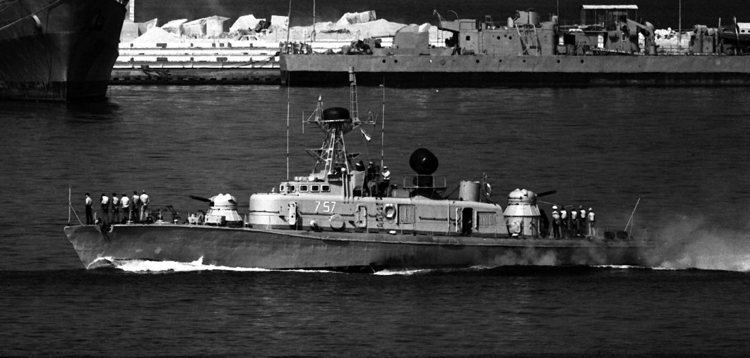Operators see below Completed 123 | Succeeded by Turya-class | |
 | ||
Name Shershen class (Project 206) Displacement 148 tons standard, 172 tons full load | ||
The Shershen-class was the NATO reporting name for a class of torpedo boats built for the Soviet Navy and allies. The Soviet designation was Project 206 Shtorm.
Contents
Development
Designated as TKAs (ru. Torpednyy Kater; eng. Torpedo Cutter), the Project 183 boats were designed as simple fast attack craft suitable for cheap manufacture and easy maintenance. Intended as a successor to the Project 183 "Bolshevik" torpedo boats, development of the new class started in 1956. Like other similar boats, they were to be used near the coast, in good weather and under friendly air cover.
The first boat was completed at the Yaroslalv Shipyard and commissioned with the Soviet Navy in October 1960. Production was also organized at the Sredne-Nevskiy and Sosnovskiy Shipyard with a total of 80 boats being built at all three shipyards. A simplified export version was designated Project 206E (NATO designation Mol). Beside Soviet shipyards, Tito's Kraljevica Shipyard in SFR Yugoslavia licence built ten original Project 206 ships for the Yugoslav Navy.
Description
Shershen-class boats measure 34.7 m (114 ft) in length, with a 6.7 m (22 ft) beam and a draft of 1.5 m (4.9 ft). Standard displacement measures 129 tonnes (127 long tons) while full displacements varies from 161 to 170 tonnes (158 to 167 long tons), depending on source and ship configuration.
Propulsion is based on three M-503A diesel engines putting out 4,000 hp (3,000 kW) each, mounted on three shafts. Maximum achievable speed is 45 knots (83 km/h; 52 mph). With a sustainable speed of 42 knots (78 km/h; 48 mph) Shershens have a range of 460 nautical miles (850 km; 530 mi) and 850 nautical miles (1,570 km; 980 mi) if traveling at a cruising speed of 30 knots (56 km/h; 35 mph). Electricity is also provided by three 28 KW diesel generators. The boats have an autonomy of up to five days and can load 30 tonnes (30 long tons) of fuel. The crew is made of 20-21 men, including two officers.
Principal armament of the class consisted of four OTA-53-206M torpedo tubes located on the sides. The 533 mm torpedoes were ejected by a powder charge and, depending on version, had a rudimentary homing ability or were straight run only. Surface search and targeting information for the torpedo attack was obtained by the MR-102 "Baklan" (NATO designation: Pot Drum) radar with a search range of 18–20 nautical miles (33–37 km; 21–23 mi). Defensive armament is made of two AK-230 CIWS located on the bow and the stern, guided by the MR-104 "Rys" (NATO designation: Drum Tilt) radar with a maximum tracking range of 12.31 nautical miles (22.80 km; 14.17 mi). Secondary armament that could be carried included twelve BB-1 depth charges or six naval mines.
Project 206
A total of 87 boats were built for the Soviet Navy between 1960 and 1970. The boats were built at yards in Zelenodolsk and Yaroslavl
Project 206 boats were exported to:
Project 206E
A simplified version, Project 206E, known to NATO as the Mol class, was built for export. One boat was retained by the Soviets to train foreign crews.
